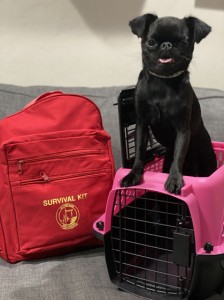Preparing Your Pets for Disasters
 Dr. Ruth, “The Pet Vet”, shares what you need to prepare your pets for a disaster
Dr. Ruth, “The Pet Vet”, shares what you need to prepare your pets for a disaster
The recent wildfires and hurricanes remind us that disasters can occur at any time. When disasters strike, there is no time for blunders. Evacuations leave little time to pack. Being ready at a moment’s notice is critical and having a disaster kit for you and your pets is essential. Dr. Ruth MacPete, aka Dr Ruth “The Pet Vet” shares how to make a pet disaster kit.
“Our pets depend on us. Being prepared for disasters ahead of time can really make a difference,” says Dr. Ruth “The Pet Vet”. “All pets should have an ID tag, a microchip and a disaster kit.”
What do you need to make a pet disaster kit?
1. A container to store all the supplies.
A duffel bag or backpack is ideal because they are easy to carry in case you need to evacuate. Be sure to store your disaster kits in a location where it is easily accessible.
2. Food and water
The American Red Cross recommends you include a two-week supply of food and water in your disaster kit. Be sure you include bowls as well as a can opener (if using canned food). I like collapsible bowls because they are lightweight and don’t take up a lot of space.
3. Toys & Treats
Include your pet’s favorite treats and toys in the kit. Many frightened animals will hide during a disaster and will not want to come out of their hiding place. Having your pet’s favorite toy on hand and ready to squeak may be what you need to entice your fearful pet out of hiding and into safety. Toys also come in handy if you need something to entertain your pet while you are waiting out the storm somewhere.
4. Leash or Carrier
Be sure to include a leash (preferably one that is reflective) for dogs or a pet carrier for cats or small dogs so that you can safely secure and transport your pet without risking that they will run away and get lost.
5. Medications
Be sure to include any medications that your pet is currently taking, including flea, tick and heartworm preventatives. You may not be able to go to your veterinarian during an emergency so have extra supplies available.
6. First aid kit
Include a pet first aid booklet and first aid supplies in case your pet gets injured and you cannot access a veterinarian.
7. Important documents
Pack a copy of your pet’s important medical records, including vaccination history and microchip information. Include a recent photo of your pet and your adoption papers to prove ownership. Also include a list of important phone numbers, such as your veterinarian, local pet emergency clinic, and boarding facilities.
8. Cat Litter & Litter Box
If you have cats, make sure you have a small litter box and small box or bag of litter ready to go. If you have to spend the night in a hotel or shelter you will need someplace for your feline friend to relieve themselves. Store these items next to your disaster kit.
Having taken the proper measures to prepare for an emergency, you have given yourself and your family the best chance for a safe outcome.
For more information or pet health tips go to: www.DrRuthPetVet.com/pet-tips
Short URL: https://caninechronicle.com/?p=190726
Comments are closed












